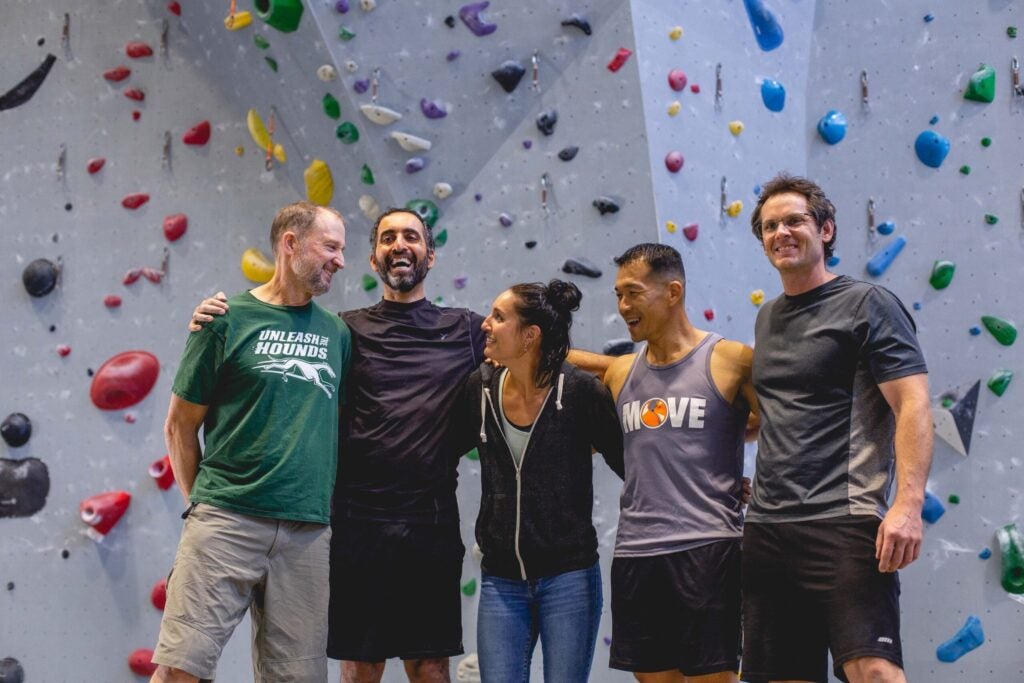No products in the cart.
Outdoor Adventure
How a Climber with Parkinson’s Started a Movement
Vivek Puri first noticed the symptoms in 2012. Instead of hanging or swinging by his side as he walked, his arm curled inward and up, his wrist hanging right around his belt buckle. It was strange, he remembers, but subtle enough that he simply adjusted his stance and moved on.
But then the 38-year-old Northern Virginia-based businessman began experiencing more symptoms. His typing suffered. His fingers would stiffen and jam. Eventually, a neurologist diagnosed Puri with neuropathy. But, after months of physical therapy with no improvement, he found himself back in the exam room.
“I remember saying, ‘By the way, I’ve noticed that when I walk, my right hamstring cramps up,’” Puri recalls. “The color just drained out of his face. I saw this visible shift in his demeanor.” The neurologist immediately arranged for Puri to see a specialist.
And so, on the morning of September 27, 2012—just 24 hours after he and his wife welcomed their third child—Puri rushed to an appointment at Georgetown University Medical Center’s Movement Disorders Clinic in Washington D.C. Less than an hour later, he was diagnosed with Parkinson’s Disease. “It was surreal,” he says.
Determined to slow the disease’s progression, Puri experimented with different therapies and exercise regimens. One day, after a prolonged struggle to find the right fit, Puri spoke with his physician. “He said, ‘I know a guy you need to talk to. He has Parkinson’s, but he’s done so many things. He rides bikes in the Rockies and goes rock climbing, all kinds of stuff.’”
The man was Jonathan Lessin, a retired physician whose efforts to mitigate his Parkinson’s symptoms catalyzed a program that would turn a climbing gym into a research facility.
***
Of the small handful of certainties and commonalities surrounding Parkinson’s treatment, perhaps the most widely understood is the critical role of exercise in slowing the disease’s progression. Not just any activity will do, however: Addressing the tremors, muscle rigidity, and neurological effects of Parkinson’s requires exercise that blends (among other things) balance, aerobics, flexibility, and strength training. This is exactly what Lessin was seeking.
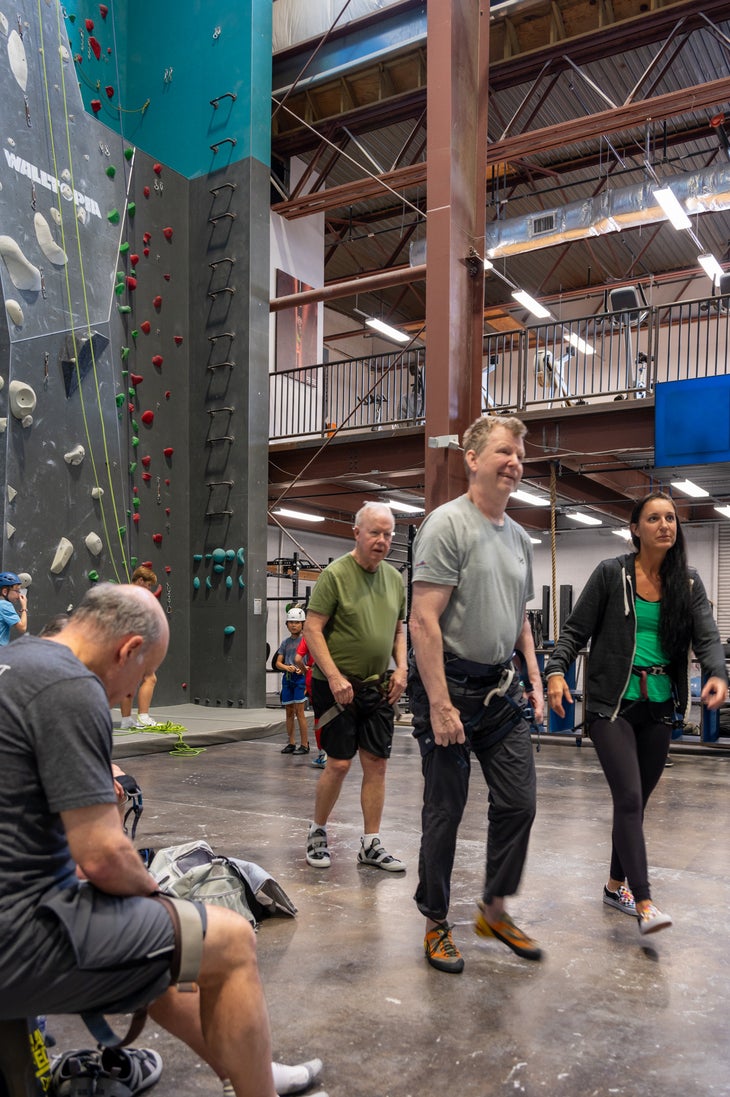
A former cardiac anesthesiologist from Chevy Chase, Maryland, Lessin began experiencing symptoms at age 33, though he wouldn’t receive a diagnosis for another five years. He retired soon after, concerned about the risks his condition posed for patients.
Like Puri, Lessin struggled to find an exercise that not only worked, but that he enjoyed. The standard recommended therapy bored him to an extreme. Trapeze lessons proved too painful and risky. He enjoyed hiking and biking, but often found himself exhausted mid-journey with several miles left to go.
Lessin needed something with big movements that engaged his body and his brain. He also needed a safe, protected environment close to home. A climbing gym, it occurred to him, might offer both.
He wanted one-on-one instruction, preferably at a low-traffic time. No one, after all, enjoys an audience watching as they Elvis-leg their way up a beginner-level climbing wall. But the first gyms he called either wouldn’t work with him or wanted him to participate in group lessons. Eventually he called SportRock Climbing Centers, a chain of gyms in the Washington, D.C., metro area. Then-manager Molly Cupka answered the phone and agreed to work with him.
“My arms were very pumped,” he recalls of his first session. “I thought, ‘This is going to be great for me.’ You’re making big movements on purpose. You’re safe because you’re tied in, and you’re never far from home.”
Best of all, it appeared to work: Within a few months, Lessin began seeing and feeling a noticeable difference. Soon, he was climbing up to four times a week.
***
By the time she met Lessin, Cupka was regularly working with aspiring climbers as a private instructor. Lessin, however, was her first client who hoped climbing might mitigate the impact of disease.
The improvement in Lessin’s symptoms was remarkable enough that his physical therapist eventually joined one of his climbing sessions, eager to gauge what made it so effective and whether it might benefit other patients. Impressed by what she saw, the physical therapist published a newsletter write-up and placed it in the clinic’s waiting room. Before long, Cupka had a growing clientele of Parkinson’s patients hoping to emulate Lessin’s results.
Cupka did her research, learning about Parkinson’s and searching for any information about the benefits of climbing for patients, but there wasn’t much to find. “I just couldn’t believe no one seemed to know about it,” Cupka says. “And Jon was like, ‘We have to tell people about this.’”
At first, Cupka and Lessin recognized that his outcomes could be anomalous. But then a second client showed improvement, followed by a third, fourth, and fifth. Calling themselves the Fidgety Five, the group began climbing together, with each member experiencing marked improvement.
By 2013, the group had grown to 25 participants and adopted the name Up ENDing Parkinson’s. In the years since, the group gained 501c3 status and spread to other gyms in Virginia, North Carolina, and Ohio. Its membership has also expanded to nearly 80 members, ranging in age from late 30s to mid-80s. Many of them compete in paraclimbing, including Puri.
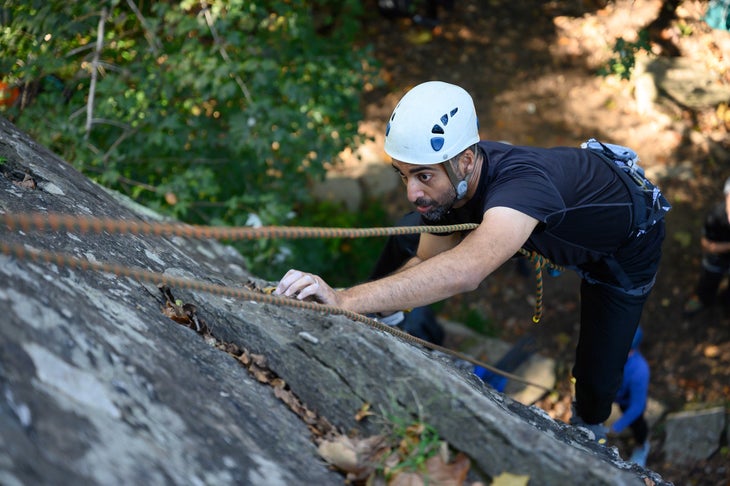
“You would watch them, and there were just these moments that you saw each of them experiencing the same benefits as the others,” Cupka says. “And you start to realize that it’s real. It’s an actual thing, and it’s actually making a difference.”
***
Given the difficulty many Parkinson’s patients encounter just walking from one room to the next, watching them climb can, at first, be astonishing. On the mornings when Up ENDing members meet, it’s not unheard of to see someone enter the gym using a walker or a wheelchair and then begin ascending the wall with seemingly less difficulty than they experience doing comparatively less strenuous tasks, like opening a carabiner or getting from one route to the next.
“I have patients who will bring their walkers into the gym and then spend 30 minutes climbing a wall,” says Virginia-based neurologist Drew Falconer, who frequently refers patients to the program. “I mean, it’s crazy. It just defies any sort of expectation of what you think is possible.”
While the disease doesn’t always shorten life expectancy, Falconer explains, it can take a drastic toll on quality of life. The average age of diagnosis for Parkinson’s is around 60 years. Men are 1.5 times more likely to develop it.
“So, you have this group of people who’ve worked their entire lives, and now they’re retiring and going to do the things they love,” Falconer says. “Then they’re told they have Parkinson’s, and you think, ‘Damn. That sucks.’ But it’s also paired with the realization that it’s not terminal. Their life expectancy is the same. So, they fight back against it, and do everything they can to live well, because it’s not going away.”
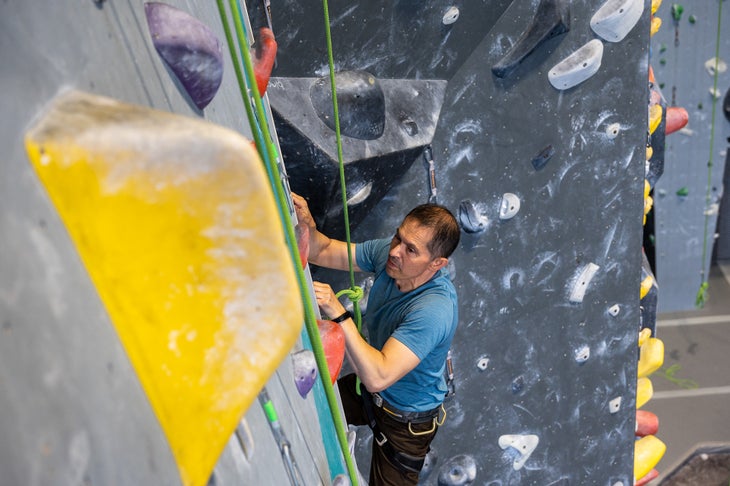
The neurological impact of Parkinson’s, Falconer continues, limits the body’s ability to ambulate through space, turning seemingly simple tasks—like tying shoes or dialing a phone number—into much greater challenges. “Climbing, in and of itself, engages so many different aspects of how our bodies move,” he says. “You’re talking strength, coordination, core muscles and balance. It’s almost the ideal exercise for someone with Parkinson’s.”
***
As the program’s grown, so has Cupka’s desire to validate its outcomes. A long-time climber, she first began working at SportRock more than 16 years ago, eventually assuming her current role as director of the gym’s location in Alexandria, Virginia. Having studied neurobiology and neuropsychology at the University of California Irvine, she often considered a career in research, even as she ascended the ranks of leadership at the gym.
That education—combined with the efforts of several well-connected group members—allowed Cupka to venture into relatively unusual territory for someone who’s spent much of her career in the fitness industry: researcher.
Several years after meeting Lessin, Cupka worked with George Washington University to conduct a small study examining the impact of climbing on a small group of Parkinson’s patients. The results proved compelling enough to gain the interest of two other researchers: Andrew Guccione, a retired professor from George Mason University, and Julie Ries, a professor of physical therapy at Marymount University.
Together, the three launched a larger study in July 2023. By January 2024, they had enrolled 28 patients with the possibility of more. Registered with clinicaltrials.gov, the study is expected to conclude May 2024.
Cupka envisions a reality where climbing is recognized as a valid form of physical therapy for patients with Parkinson’s and other movement disorders.“I want insurance to cover this,” she says. “It’s a no-brainer.”
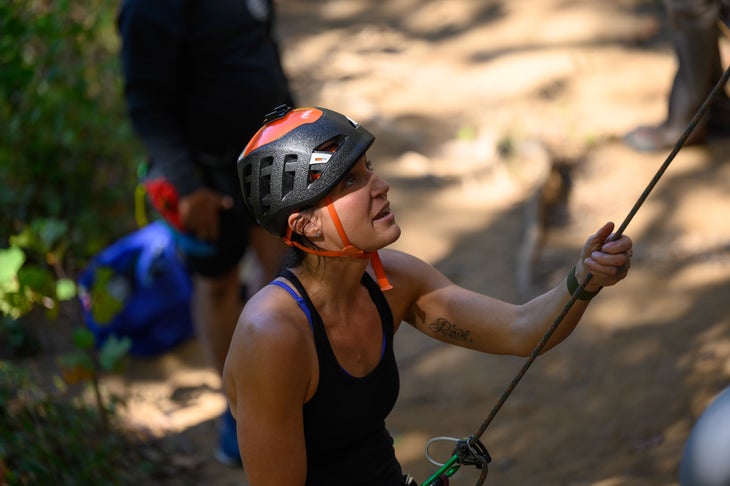
***
If Mark Twain was right, and there truly is no such thing as a new idea, then someone, somewhere has also connected climbing and Parkinson’s. But if they’re out there, they’re maintaining a low profile.
“I think Parkinson’s and climbing just seem like such an unlikely pairing that people just don’t put the two things together,” Falconer says. “Maybe in some cases it comes down to bias: When we think about Parkinson’s, there’s nothing about it that seems conducive to climbing a rock wall.”
Even as the benefits of climbing for Parkinson’s appear increasingly more concrete, there are limitations. The gains that appear so soon after participants begin climbing can subside just as quickly. That makes consistency crucial—something Puri learned soon after an injury forced him out of the gym for two weeks.
“Within just a few days, I found myself needing more medication,” he recalls. “I was less mobile, less everything. There were clearly benefits that I wasn’t getting because I wasn’t climbing anymore.”
While the physical impact of climbing is critical, Falconer says, so are the psychological and emotional effects for people with Parkinson’s. Because the disease affects areas of the brain that produce dopamine and other mood-regulating chemicals, patients commonly suffer from depression, making it difficult to maintain motivation and hopefulness.
“I think one of the coolest parts about climbing with Parkinson’s is that it gives an outlet for these people who are struggling every day to live with what they’ve been given,” Falconer says. “It allows them to prove to themselves that they can do it. And there’s nothing more inspirational than that.”
[Related: Our Best Articles About Mental Health and Climbing]
Source link

